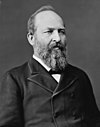
William Allen was a Democratic Representative, Senator and 31st governor of Ohio.
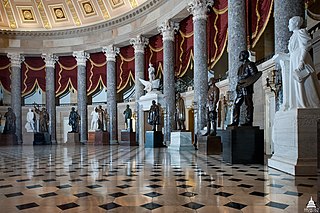
The National Statuary Hall is a chamber in the United States Capitol devoted to sculptures of prominent Americans. The hall, also known as the Old Hall of the House, is a large, two-story, semicircular room with a second story gallery along the curved perimeter. It is located immediately south of the Rotunda. The meeting place of the U.S. House of Representatives for nearly 50 years (1807–1857), after a few years of disuse in 1864 it was repurposed as a statuary hall; this is when the National Statuary Hall Collection was established. By 1933, the collection had outgrown this single room, and a number of statues are placed elsewhere within the Capitol.

The National Statuary Hall Collection in the United States Capitol is composed of statues donated by individual states to honor persons notable in their history. Limited to two statues per state, the collection was originally set up in the old Hall of the House of Representatives, which was then renamed National Statuary Hall. The expanding collection has since been spread throughout the Capitol and its Visitor's Center.

Charles Henry Niehaus, was an American sculptor.
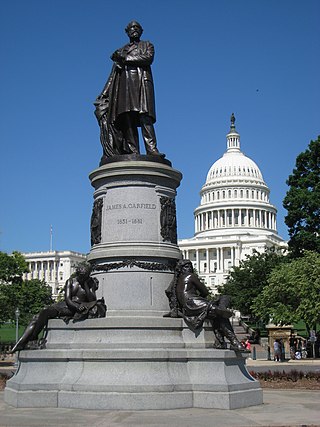
The James A. Garfield Monument stands on the grounds of the United States Capitol in the circle at First Street, S.W., and Maryland Avenue, Washington, D.C. It is a memorial to United States President James A. Garfield, elected in 1880 and assassinated in 1881 after serving only four months of his term, by a disgruntled office-seeker named Charles J. Guiteau.

The Peace Monument, also known as the Naval Monument or Civil War Sailors Monument, stands on the grounds of the United States Capitol in Peace Circle at First Street, N.W., and Pennsylvania Avenue, Washington, D.C. The 44 foot high white marble memorial was erected from 1877 to 1878 in commemoration of the naval deaths at sea during the American Civil War. Today it stands as part of a three-part sculptural group including the James A. Garfield Monument and the Ulysses S. Grant Memorial.

The United States Capitol rotunda is the tall central rotunda of the United States Capitol in Washington, D.C. It has been described as the Capitol's "symbolic and physical heart". Built between 1818 and 1824, the rotunda is located below the Capitol dome, which was built between 1857 and 1866.

Franklin Bachelder Simmons was a prominent American sculptor of the nineteenth century. Three of his statues are in the National Statuary Hall Collection, three of his busts are in the United States Senate Vice Presidential Bust Collection, and his statue of Ulysses S. Grant is in the United States Capitol Rotunda.
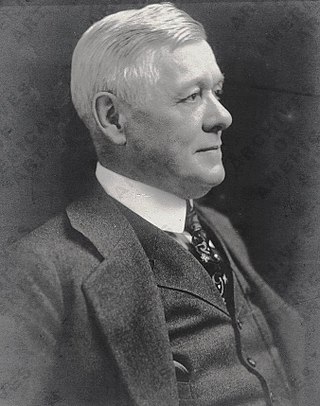
John Massey Rhind was a Scottish-American sculptor. Among Rhind's better known works is the marble statue of Dr. Crawford W. Long located in the National Statuary Hall Collection in Washington D.C. (1926).
Robert E. Lee is a bronze sculpture commemorating the general of the same name by Edward Virginius Valentine, formerly installed in the crypt of the United States Capitol as part of the National Statuary Hall Collection. The statue was given by the commonwealth of Virginia in 1909. On December 21, 2020, the sculpture was removed from the grounds of the United States Capitol and relocated to the Virginia Museum of History & Culture.

Jefferson Davis, created by Henry Augustus Lukeman, is a bronze sculpture of Jefferson Davis – a U.S. Senator, U.S. Secretary of War, plantation owner and the only President of the Confederate States of America – commissioned by the U.S. State of Mississippi for inclusion in National Statuary Hall Collection at the United States Capitol's National Statuary Hall, in Washington, D.C. The statue was controversial at the time of its unveiling and there have been multiple efforts to remove it from the Capitol since 2015.

The National Statuary Hall Collection holds statues donated by each of the United States, portraying notable persons in the histories of the respective states. Displayed in the National Statuary Hall and other parts of the United States Capitol in Washington, D.C., the collection includes two statues from each state, except for Virginia which currently has one, making a total of 99.

Henry Clay is a 1929 bronze sculpture by Charles Henry Niehaus depicting the lawyer and politician Henry Clay, installed in the United States Capitol in Washington D.C. as part of the National Statuary Hall Collection. It is one of two statues donated by the state of Kentucky. The statue was accepted into the collection by Virgil Chapman on March 3, 1929.

John James Ingalls is a 1905 marble sculpture of the politician of the same name by Charles Henry Niehaus, installed in the United States Capitol, in Washington D.C., as part of the National Statuary Hall Collection. It was one of two statues donated by the state of Kansas. The statue was accepted in the collection by Senator Arthur P. Gorman on January 21, 1905. On July 27, 2022, it was replaced by a Statue of Amelia Earhart.

William Allen is a sculpture depicting the American politician of the same name by Charles Henry Niehaus. The statue was gifted by the U.S. state of Ohio to the National Statuary Hall Collection in 1887, but later replaced with one of Thomas Edison due to Allen's pro-slavery viewpoints. Allen's statue was relocated to the Ross County Heritage Center, in Chillicothe, Ohio.
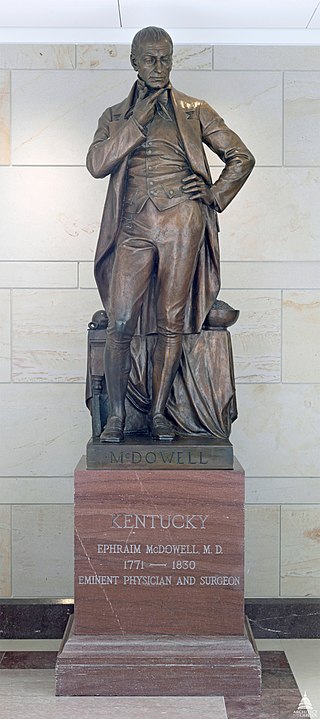
Ephraim McDowell is a bronze sculpture depicting the American physician and surgeon of the same name by Charles Henry Niehaus, installed in the United States Capitol Visitor Center, in Washington, D.C., as part of the National Statuary Hall Collection. The statue was gifted by the U.S. state of Kentucky in 1929.
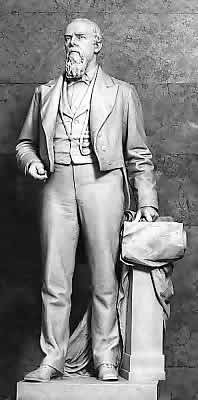
Oliver P. Morton is a 1900 marble statue of Governor Oliver P. Morton by Charles Henry Niehaus installed in the United States Capitol, in Washington, D.C., as part of the National Statuary Hall Collection. It is one of two statues donated by the state of Indiana. The statue was accepted into the collection on April 14, 1900, by Indiana Senator Albert J. Beveridge.,
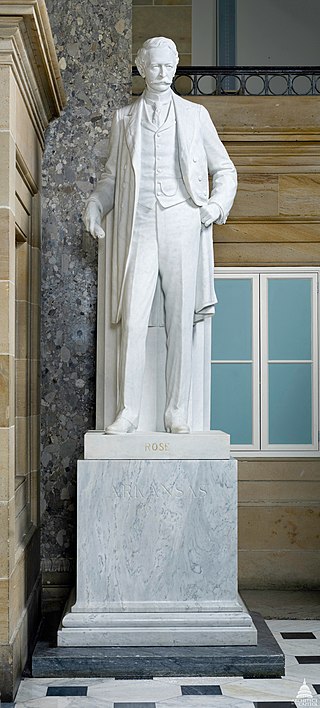
Uriah M. Rose, or Uriah Milton Rose, is a marble sculpture depicting the American lawyer of the same name by Frederick Ruckstull, installed in the United States Capitol's National Statuary Hall, in Washington, D.C., as part of the National Statuary Hall Collection. The statue was gifted by the U.S. state of Arkansas in 1917.

Zachariah Chandler is a statue depicting the politician of the same name by Charles Henry Niehaus, formerly installed in Washington, D.C., representing the U.S. state of Michigan in the National Statuary Hall Collection. In 2011, the statue was relocated to the atrium of Lansing's Constitution Hall, and replaced by another depicting Gerald Ford.
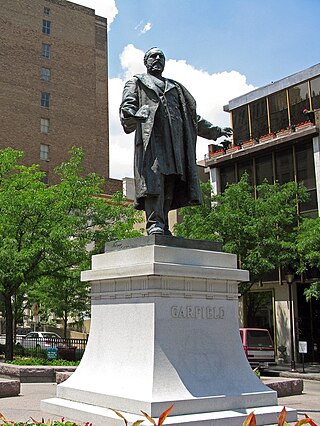
A statue of James A. Garfield by Charles Henry Niehaus stands in Piatt Park, Cincinnati, Ohio, United States.


















